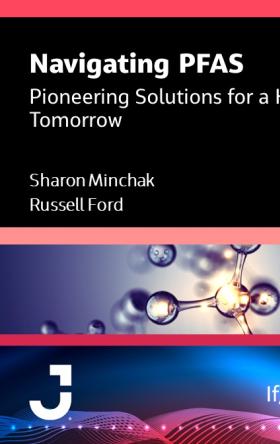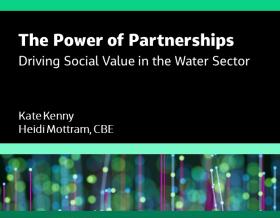
Of the various quotes about achieving success, this one from basketball legend Michael Jordan has to rank near the top in terms of its applicability to business. Number 23 once said, “Talent wins games, but teamwork and intelligence wins championships.”
When it comes to the high-stakes, ultra-competitive world of digital technology, the smart players realize they can’t always go it alone. Following Jordan’s advice, sometimes the best path ahead lies in creating alliances with other skilled players to augment each other’s abilities and share insights and information to attack challenges in new and previously unforeseen ways.
One way to do this in business is to invest, acquire and collaborate. To learn more about how Jacobs identifies and creates an ecosystem of technological alliances to serve the growing needs of our clients, we spoke with John Karabias, Jacobs vice president of strategy and head of digital innovation. John’s remit is to help develop the business strategy for Jacobs’ Divergent Solutions operating unit, with an emphasis on investments, partnerships, market intelligence and go-to-market solutions.
Hi, John. Can you share a little bit about how Jacobs evaluates the opportunity to create potential strategic alliances with outside entities?
We start with our clients and our programs. We ask, “What are the outcomes that they're trying to enable, and what may be the additive technology or vendor solution that may be able to help enable that solution in a way that's complementary to the services that we are providing?” We begin with a market-centric and client-centric view of what’s relevant and interoperable within the environment. We don’t try to have hundreds of technology partners. Instead, we look at where in that Venn diagram we see partnerships that have applications across significant parts of our business, that may be within a market supporting a number of programs, and that ultimately we can create a one-to-many methodology of scale.
A great example of that is the Jacobs and Palantir global strategic partnership where data aggregation and data analysis was a use case that we were seeing across our business. It made sense for us to establish an agreement and really focus with them on curating a solution, leveraging their platform to allow Jacobs to solve a specific business problem. Jacobs’ domain knowledge and the Palantir technology platform is a recipe for solving these growing data challenges in a variety of client environments.
It's not just about gaps, however. We also consider the questions, “Could we significantly advance solution delivery? Could we bring technology that is a step change above and beyond what is being delivered?” Oftentimes, it’s a question of, is there a technology or capability that the client may not even be aware of? Through our technology understanding, we're trying to guide the client to the next level of possibility for their mission. We want to be forward leaning around what's possible for our clients in a way that can have transformational benefits, not simply about tinkering around the edges. Our partnership solutions often are advancing a new technological paradigm for our clients that’s as much about the willingness to change and adapt the culture as it is about the technology itself.
Are there different types of alliances that a company like Jacobs enters into? Can you share with us the differentiations?
We use a framework called Build, Buy, Partner. For “Build” we look at considerations such as, “What are we going to develop and deliver organically within Jacobs? What's the cost of that? What's the business case for doing that?” Then there is “Buy,” when we ask where we might want to look at an acquisition because speed of acquiring a capability or access to a market is really important, such that the return on a significant investment warrants an acquisition. Then there's “Partner”, which focuses on the question of who we are partnering with and who has technology that we could curate and create into a Jacobs solution? Our strategic alliances roadmap is derived from the balance of how those three approaches work together to meet our business needs. It's a strong framework that drives a lot of our actions.
Some of the underlying agreement types become acquisitions, and some as venture or equity investments, where we will invest in a company aligned to our market. Our venture investments typically have a couple of benefits. One is being able to understand and learn about a technology in its infancy, before it moves up that full adoption curve and with which we think that technology may have a disproportionate effect on the market we're working in. In other cases, it’s about deploying that venture technology right away. In some cases, we've established a partner agreement, and not only are we investing, but we've got a commitment to work together to leverage that technology in the market in a way that is a win-win for Jacobs, the venture company and the client who may not have access to the early stage emerging technology.
How are potential business models determined?
We've worked closely with our technical subject matter experts and our lines of business to figure out how to build the right technical solution combined with how to get that on contract with a client. Our intent is to create a repeatable, consulting-oriented capability for Jacobs that allows us to not only implement a product on a specific project, but to deliver solution-enhancing services on an enduring basis for our clients.
For instance, if we’re delivering supply chain analytics, the approach would be not to just get a customer the underlying vendor software. We’d also want to extract the insights from that software, relevant to their domain, so that that customer understands the contextual insights of supply chain on a regular basis with Jacobs’ subject matter consulting services. It’s that formula that shows how Jacobs can help our clients not only get the underlying product or software, but also how our services can help them extract the value to their mission or outcome.
How is it determined when to do an M&A, when to invest a la corporate venture capital (CVC), and when to simply put an agreement in place that doesn’t involve one entity purchasing or investing in the other?
The Build/Buy/Partner framework I mentioned earlier is fundamental to answering this question, asking, “Is it really important that we quickly leverage another company's capabilities or market access, and is there a disproportionately high impact to our business from acquiring those things?” If the answer is yes, then M&A is a critical part of that equation.
If we like or are exploring a technology area or market and think that there is a future impact, and that impact can be both offensive (meaning, we want to go out and grow work,) or defensive (meaning, we need to protect against disruption in an area that we're strong in now and therefore we may need to understand this disruptive technology,) that often is when we're thinking about a CVC. If we think, simply by establishing a partnership that allows us to access a technology in a way that's equitable both to us and to that partner, then we look at partnerships leveraging some of the business models that I mentioned earlier.
About the interviewee

John Karabias is the Vice President, Strategy for Jacobs' Divergent Solutions (DVS) operating unit. In his role, John develops business strategy for Divergent Solutions inclusive of investments, partnerships, market intelligence and go-to-market solutions. Prior to joining Jacobs, John served in various program and sales leadership roles at organizations such as Engility, SAIC and RTR Technologies. In these roles, he successfully captured multiple contract awards for U.S. Army, U.S. Navy, and U.S. Customs and Boarder Protection programs. John also built sophisticated market ontologies related to client needs aligning core company offerings and early-stage internal research and development capabilities to customer requirements. He is a practitioner of Agile and DevOps and has helped customers transform their organizations through the implementation of tailored Agile and DevOps solutions at scale.
About Intelligent O&M

Intelligent O&M is a powerful blending of Jacobs’ water subject matter expertise in operations, design and data science, with Palantir’s Foundry platform and user interface, that provides direct and predictive guidance to frontline O&M staff.
Across industries — from manufacturing to mining to water treatment — plant operations are largely reactive. In these cases, management is only alerted to issues when equipment malfunctions or reviews reveal underperformance. This creates dependencies on lagging performance indicators and a broader focus on troubleshooting, rather than proactive modeling and operations. Decision-makers need real-time visibility into plant operations with leading performance indicators that can help them optimize performance before it is too late.
When site staff operators in the field are bombarded with noisy Supervisory Control and Data Acquisition (SCADA) systems and information overload, it’s incredibly difficult to distil actionable insights, forcing operators to rely on gut-based, qualitative decision-making. Operators need innovative digital tools that make their lives simpler, not more complex. They need IT that’s customized to their day-to-day workflow and actually works in the field.
With the Palantir Foundry platform and Jacobs’ smart algorithms and wastewater process optimization tools such as Replica™, plant management and site staff are armed with the practical data science tools needed to conduct proactive, data-driven operations, maximizing performance and cost savings plant-wide.

















































